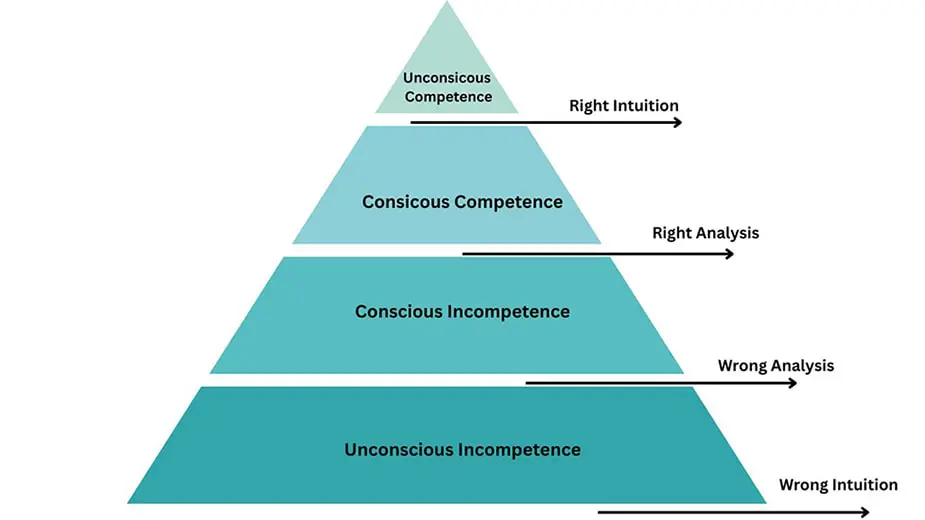We’ve all been there. That moment you look back at something you once proudly delivered—and cringe. Maybe it was a deck. A website. A client workshop. A product you thought would “revolutionise the industry” but instead… quietly flopped.
Welcome to the Four Stages of Competence:
The psychological roadmap shows how we go from confident mess to capable expert.
It’s humbling, sometimes hilarious, and incredibly relevant for modern businesses especially when you’re leading teams, launching products, or growing brands. Because knowing where you are on the map is just as important as knowing where you’re going.
🪤 Stage 1: Unconscious Incompetence
“This looks fine to me.”
This is the blissfully unaware phase. You don’t know that you don’t know-and you may be succeeding despite yourself.
Take early-stage businesses building their first product. They assume “If we build it, they will come,” and slap together a website on a no-code builder with Comic Sans and six call-to-action buttons. Then they wonder why no one’s clicking anything.
This stage is where you think the UI is “clean” because it has white space, but users can’t find the checkout button. You think you’re nailing it, but you’re unknowingly repelling your customer.
The moment you realise this? That’s when growth begins.
Real-World Example: Juicero
Remember Juicero? The $400 WiFi-enabled juicer that required proprietary juice packets?
Investors poured in millions. But when a Bloomberg article showed that you could squeeze the juice packs with your hands just as well, the internet (and customers) lost it.
Juicero didn’t realise how out of touch they were with actual user needs—classic unconscious incompetence, dressed up in Silicon Valley hype.
Takeaway:
Bringing in experts early is cheaper than fixing the mess later:
📉 Stage 2: Conscious Incompetence
“Okay, this might be more complicated than I thought.”
You’ve seen the red flags: Bounce rates are high. Customer feedback is… pointed. Revenue is stalled despite everyone working overtime.
The good news? You now know what you don’t know.
This is when smart founders bring in UX strategists, brand designers, or data analysts. You start understanding what good looks like—and how far you are from it.
Real-World Example: Nokia
Nokia dominated the mobile phone market for a decade. But when smartphones changed the landscape, Nokia knew they didn’t have the answers-yet clung to old models, slowly realising they lacked the UX and software expertise to keep up.
By the time they saw it, Apple and Android were miles ahead.
Takeaway:
Awareness is powerful-but don’t stop there. Get help, ask questions, and build the muscle.
⚙️ Stage 3: Conscious Competence
“We’ve got a process now.”
Here’s where you’re running a tight ship. You’ve got systems. You do user research before launching features. Marketing and product are talking. You’re tracking the right KPIs and using them to make decisions.
You still make mistakes-but they’re smaller. Recoverable. You can explain your thinking and adjust quickly.
Real-World Example: Mailchimp
MailChimp evolved from a small email tool to a full-fledged marketing platform by listening to users, testing religiously, and iterating with intention. They didn’t always get it right, but they learned fast—and scaled while still learning.
Takeaway:
You’re learning fast, building well-just don’t rush the process.
🧘♀️ Stage 4: Unconscious Competence
“We’ve built instincts you can trust.”
This is mastery. Your team has internalised the process. You don’t need checklists to build great flows. Everyone-from interns to execs-thinks in systems. Design is intuitive. Copy is strategic. Metrics are baked in.
But this stage comes with a new danger: complacency. Or worse: innovation for the sake of it.
Real-World Example: New Coke
In the 1980s, Coca-Cola was winning. But in a move nobody asked for, they decided to “modernise” the formula and released New Coke. The backlash was instant.
Why? Because the old Coke formula wasn’t broken. They were unconsciously competent-running a well-oiled, beloved machine. But instead of trusting that, they felt the need to reinvent just to feel busy.
Takeaway:
If it’s working, protect it. Don’t fix what isn’t broken just to feel innovative.
The Four Stages of Competence isn’t just a training model—it’s a mirror.
-
-
- Stage 1 reminds you to stay humble.
- Stage 2 reminds you to ask for help.
- Stage 3 reminds you to stay consistent.
- Stage 4 reminds you to protect what’s working-and not to get fancy for the sake of it.
-
The smartest leaders I know are constantly scanning for signs:
Are we guessing? Are we overconfident? Are we overbuilding?
Knowing where you are on the competence curve can save you from expensive mistakes—and unlock faster, more intentional growth.
🔄 We’ve Been Every Version of This Ourselves
At Azul Arc, we’ve found ourselves in every single one of these stages—sometimes all at once. And honestly? That’s been one of our biggest advantages.
We’ve learned the value of partnering with people we can be vulnerable with-because no one is competent in everything. Even if you know the methodology inside out, applying it to each client’s unique challenge is a whole different game. That openness has sharpened our thinking and made our solutions stronger.
With Renderlab-our visualisation and prototyping engine that brings custom digital products to life—we operate at conscious competence. We know how to build things well-and we’ve got the results to show for it. But the level of customisation and the pace of iteration means we stay sharp, humble, and always alert to new edge cases. Competence, yes—but earned daily.
And we stay wary of unconscious incompetence, especially when it comes to emerging trends. We love staying current in tech, UX, and product, but we filter everything through one lens:
Does this serve the customer?
If not, it’s just noise.
We’re not trying to be flawless. We’re trying to be aware. And that’s made all the difference.
Want to find your next level of competence?
Wherever you are on the curve, we can help you move forward-strategically, collaboratively, and without the growing pains.
Let’s talk.
